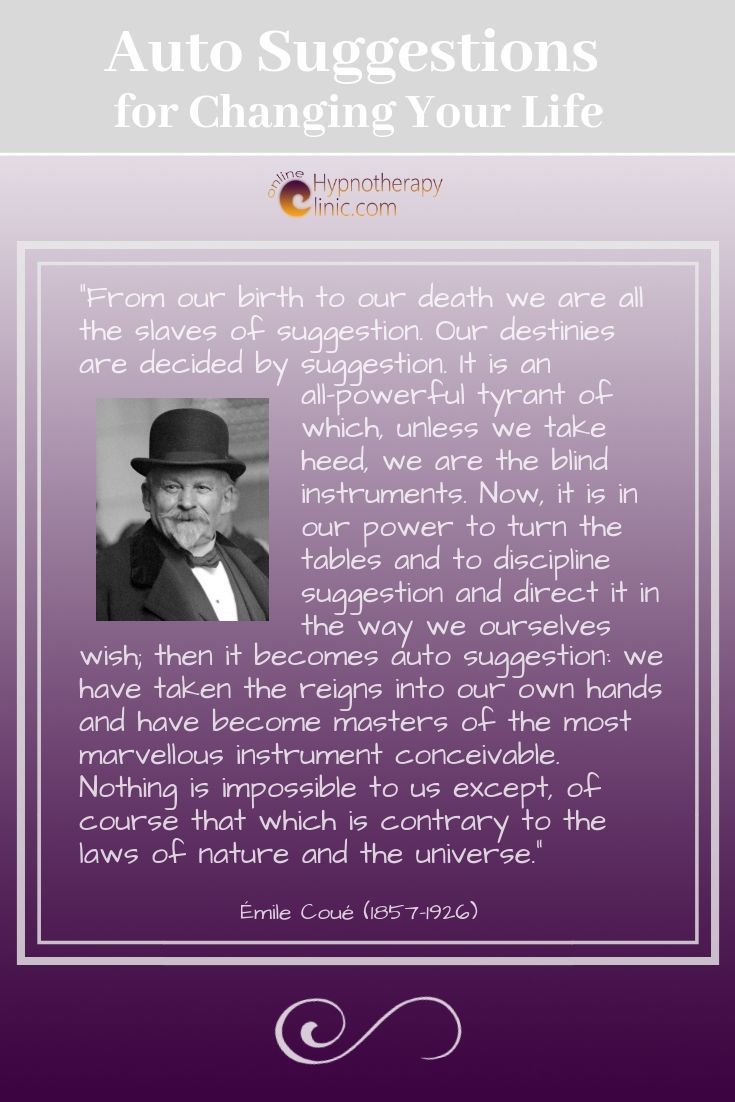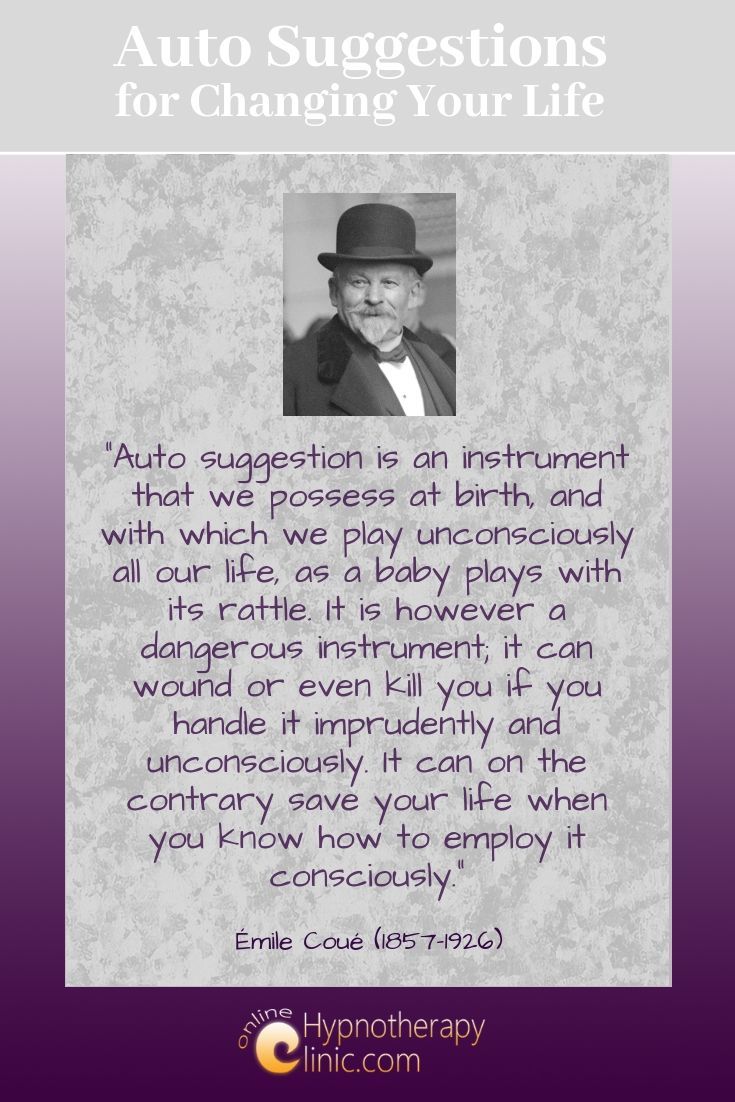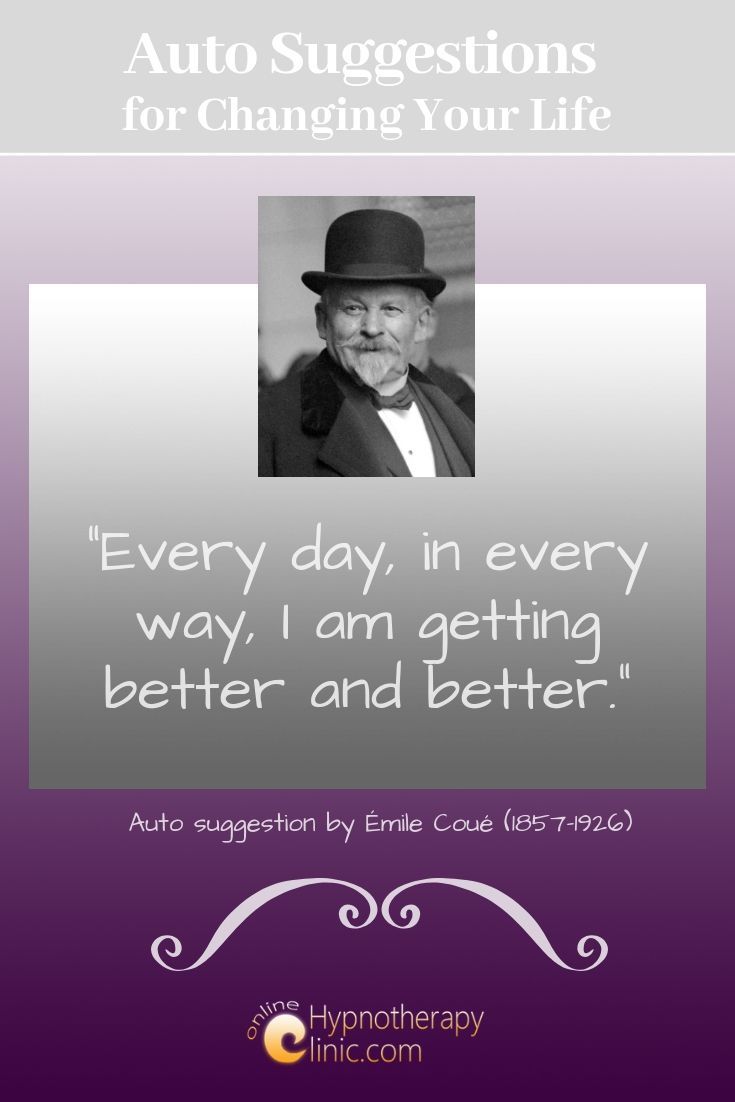Auto Suggestions for Changing Your Life- A Complete Guide
Includes 9 Self Hypnosis Affirmations for Increasing Positivity In Your Life
By Susanna Sweeney, MSC, MBACP, CHT
In this article, find out the history of auto suggestions, the science behind them and how you can use them to your advantage to change your life.
What are Auto Suggestions?
In hypnosis terms, suggestions are statements made with the intention of influencing someone's mindset. The hypnotist uses suggestions when they want to change the way the client thinks about something, wants to change their feelings towards something, or wants to inspire positive emotions.
An auto suggestion then, quite simply, is a suggestion is a suggestion you make to yourself. Typically such suggestions are used to focus your mind, or to motivate and inspire you towards a particular goal, for example to stop smoking or to lose weight. These days, auto suggestions are more commonly referred to as affirmations.
You have probably heard about affirmations and may very well have used them. But did you know that the idea of using affirmations to change your life goes back to the work of one man AND is over 100 years old?
I bet you had no idea. Not many people are aware of this piece of hypnosis history.
In this article, I want to introduce you to the life and work of Émile Coué (1857- 1926) and retrace his thinking process for you so that you can understand the concept of affirmations or auto suggestions from the ground up.
The Pioneer of Auto Suggestions- Émile Coué (1857- 1926)
Frenchman Émile Coué was born in humble circumstances in Troyes, France. He studied pharmacy in Paris, then returned to his hometown to open a pharmacy and drug store.
Hypnosis lectures and hypnosis stage shows were very popular at the time, and one day Émile stumbled upon such a lecture by the famous hypnotist Ambroise-Auguste Liébeault (1823- 1904) whom he subsequently befriended and started to work with in the hypnosis field, opening a hypnotherapy clinic in Troyes.
Émile was struck by parallels he observed in his hypnosis and pharmacy work. It was his observation that the patient's belief in the cure offered made a substantial difference to whether the cure would work for him or her, or not.
He started to believe that the suggestions he gave were more powerful than the medicines or the hypnosis themselves and that all healing was largely due to a placebo effect: if a patient believed the medicine would heal him, his chances of healing were much greater than if he did not.
As a result- along with the medicines he sold, he started feeding his patients suggestions to help their healing and continued to do so for many years. By the end of the century however, he moved away from being the giver of suggestions.
he came to believe that it was a much more empowering experience for patients if they became their own masters- designing and administering their own suggestions because ultimately, suggestions would only work if the person proceeded to internalize the message given.
This idea formed the background to Émile's concept of 'conscious auto suggestions'.
Whatever the healing method used- be it medicines or hypnosis- in Émile's view the healing was due to auto suggestion, and if the patient could be taught and encouraged to design and use auto suggestions, this would work so much better. rather than hypnotizing his patients, he now started to teach them how to design and use auto suggestions- all while they were in a fully conscious and wide awake state.
His recommendations on how to use auto suggestions were to use general suggestions daily, as well as specific ones that target specific goals or issues. You should recite these to yourself several times a day, in other words, Émile saw repetition as key in being successful with suggestions. Repetition would ensure acceptance by both conscious and subconscious minds, and a suggestion could only be realized once fully embraced.
Émile became a tireless proponent of the idea of auto suggestions, promoting the concept widely. He wrote books and went on lecture tours. Émile's ideas became famous all over the world. He had centres in Paris, London, and even New York. However, after his death in 1926 the craze for his ideas faded away within about ten years.
This, however, was not the end of the use of auto suggestions.
Auto Suggestions Today
The New Age movement popularized the idea of auto suggestions once more and certainly since the movie 'The Secret' was released public fascination with self hypnosis affirmations has become wide spread.
Commonly they are now referred to as affirmations- but beware-not all affirmations are created equal. If you get the design wrong, they won't work for you or- at worst, will work against the very thing you are trying to achieve!
Read my article on auto suggestion techniques to make sure yours are designed right and that you are getting the best out of them.
The Scientific Case for Auto Suggestions
Émile Coué claimed that even physical ailments could be treated- or at the very least helped- by auto suggestions. This idea has been confirmed by research in the fields of psychosomatic medicine and psychoneuroimmunology. The concept of psychological modulation of immune function has become widely accepted in these fields.
Here is a random selection of examples for scientific evidence for the mind body link as well as for the powerful role of suggestions. I have chosen these to illustrate the wide range of issues that suggestions and auto suggestions can help with.
For example:
- Stress and disease have been linked to developmental issues in very young children such as insecure attachment. (1)
- Hypnosis and suggestion have been used successfully to treat warts. (2)
- Suggestions have been used successfully to treat irritable bowel syndrome. (3)
- Aided by PET imaging, researchers demonstrated the successful use of hypnotic analgesic suggestion. (4)
- Self hypnosis involving auto suggestions has been shown to decrease anxiety levels. (5)
- Suggestions were used successfully as a part of the treatment for the symptoms of child sexual abuse. (6)
- Hypnotherapy treatment involving suggestions was used successfully to treat depression. (7)
I have also written articles on the scientific background to using stop smoking hypnosis and weight loss through hypnosis. (Hypnosis treatment for these issues will always be based on suggestion hypnosis over regression hypnosis.)
What can You Achieve Using Auto Suggestions ?
You can use self hypnosis affirmations to make changes in your life in a lot of different areas:
- You can boost self esteem and confidence with auto suggestions.
- You can get relief from the symptoms of anxiety and depression through suggestion (administered by someone else) or auto suggestion.
- You can get relief from obsessive ideas, and obsessive compulsive behavior.
- You can get rid of the self destructive smoking habit through suggestions by using self hypnosis for smoking.
- Auto suggestions in self hypnosis for weight loss are fantastic help that can make weight loss easy.
- Auto suggestions can help you achieve your goals of any nature, be they educational or sporting goal, career, financial or health goals.
- You can even change your emotional state with auto suggestions when you feed yourself the right messages about what you would prefer to feel. This can be a very useful mind power technique for mastering emotions.
9 Auto Suggestions or Self Hypnosis Affirmations for Bringing Positivity Into Your Life
What is Hypnosis? Other Articles on This Topic
Understand the Basics
Discover the Power of Hypnosis
Discover the power of hypnosis through 10 amazing facts about hypnosis you most likely have not heard before.
Six Wonderful Benefits of Hypnosis for Creating the Life you Love
Find out the benefits of hypnosis over coaching and traditional talk psychotherapy in helping you change your life for the better and achieving your goals.
You may have heard anecdotal reports about hypnosis being nothing more than unscientific ‘mumbo-jumbo’ which might have planted this question in your mind. So, does hypnotherapy work? Find out my answer to this charged question, and it probably isn't what you would expect.
The 3 Worst Mistakes Hypnotists Make
Find out the three worst mistakes any hypnotist can make so that you can avoid them and find the right hypnotist for you.
Evolution has given humans a powerful tool that enables us to be the most dominant species on the planet- yet this tool contains a critical flaw that is limiting many people and preventing them from living their dream. This may be limiting you, too...
The Secret Language of Hypnotherapy
Learn the secret language of hypnotherapy geared towards the requirements of your subconscious mind so that you can reach your goals more easily.
Find out the most common issues that hypnosis can help you with and see what you could do with hypnosis to change your life.
This article is a great starting point to understanding what to expect from hypnotherapy treatment, including what you can do to get the most from your treatment.
Hypnosis has been shrouded in mystery. There are many myths or, simply, false beliefs attached to hypnosis. You, too, have likely picked up a few of them as they are ‘around’ in public consciousness. Let me bust those myths for you so you can be free to enjoy and appreciate hypnosis for what it is.
Hypnosis or Self Hypnosis Trance
Hypnotic trance is referred to with much mystery. Is it really that spooky? Allow me to talk you through what the experience is like.
Hypnosis Methods and Ways of Working
This article covers everything you want to know about suggestion hypnosis, including what it is, what it can do for you, how it works, what techniques are used and how you can get the very best out of it. Suggestion hypnosis can help you to reach your goals and change your life.
Regression Hypnosis can help you to clear blocks relating to the past which are causing you trouble now. Find out how it works, how it compares to coaching and psychotherapy and see if it is suitable for you.
This article fills you in on how you can get the very best from regression hypnosis and is a must read if you are thinking of embarking on hypnotherapy treatment for a complex personal issue.
Some hypnotists offer specific sessions to uncover past life memories. Is this a good idea? Find out what my thinking is on how to get the best results from past life hypnosis.
Does online hypnotherapy work or is it inferior to face to face work as some people say? Find out what's involved and form your own opinion about advantages and disadvantages working online with us.
What is Havening and how Can it Help you Change Your Life?
Find out about a novel psychosensory treatment we combine with hypnosis which can help you clear trauma, fears, phobias, anxiety, low self esteem and more while also supporting you in building resilience and positive emotions.
Discover how well hypnosis could work for changing your particular bad habit and how you can make it into a starting point for changing your life.
Hypnosis for Permanent Rapid Change
No more scripts. The new way to work with live issues. It's dynamic, fast, gentle and powerful.
Self Help Hypnosis Articles
Can you help yourself with hypnosis? Find out here...
You will find this question answered but in a way you probably would not expect. Find out how self hypnosis is always at work, whether you harness it as a skill or not...
The Benefits of Self Hypnosis
Find out in this article how you can benefit from self hypnosis in your life, including what issues you can use it for.
Self-Hypnosis Relaxation Techniques
A good place to start practicing self hypnosis techniques first before infusing them with images regarding your specific goals, or changes that you want to make in your life is with relaxation techniques. Find a sample relaxation script on this page that you can start using today.
Self Hypnosis for Goal Setting
Goal setting is key in working with personal goals. If you don’t get your goals just right, you are much less likely to get good results. Find out how to overcome the seven most common mistakes with goal setting when you use a self hypnosis based approach.
Self-Help Hypnosis- 7 Challenges and How to Overcome Them
Like any other form of therapy, self-help hypnosis, too has some limitations which you should be aware of before you start practicing. I also offer some practical tips and solutions to help you overcome most of these limitations.
Auto Suggestions
In this article, find out the history of auto suggestions, the science behind them and how you can use them to your advantage to change your life.
In this article, find detailed instructions on how to design, administer and troubleshoot your auto suggestions successfully so that you can use them to change your life.
I hope you enjoyed this brief article on auto suggestions. Read on about auto suggestion techniques to find out how to design and administer suggestions that can help you to change your life.
Here is to your success and well being.
Regards,

References:
(1) Maunder, Hunter, 2001. Attachment and Psychosomatic Medicine: Developmental Contributions to Stress and Disease. Psychosomatic Medicine, July-August 2001, Vol. 63, Iss. 4, p. 556-567
(2) Spanos, Stenstrom & Johnston 1988. Hypnosis, Placebo, and Suggestion in the Treatment of Warts. Psychosomatic Medicine 50:245-260 (1988).
(3) Lupu & Lupu, 2017. Cognitive Behavioral Hypnotherapy in a Case of Irritable Bowel Syndrome, Journal of Evidence Based Psychotherapies, Vol. 18, No. 1; March 2018, p. 35-44
(4) Nussbaum, Redoute, Le Bars et. al., 2010. Chronic Low- Back Pain Modulation is enhanced by Hypnotic Analgesic Suggestion by Recruiting an Emotional Network: A PET Imaging Study, International Journal of Clinical and Experimental Hypnosis, November 2010.
(5) VandeVusse L, Hanson L, Berner MA, White Winters JM (2010). Impact of self-hypnosis in
women on select physiologic and psychological parameters. Journal of Obstetric, Gynaecologic and Neonatal Nursing 39(2): 159-168.
(6) Fourie & Guse, 2011. An Integrated Hypnotherapeutic Model for the Treatment of Childhood Sexual Trauma: A Case Study. American Journal of Clinical Hypnosis, 53/3.
(7) Alladin, 2010. Evidence Based Hypnotherapy for Depression, International Journal of Clinical and experimental Hypnosis, 58/2, p. 165-185.
Recent Articles
-
Havening Technique Training auf Deutsch
Apr 18, 25 02:59 AM
Havening Technique Training auf Deutsch- Details und Buchung -
Client Testimonials
Oct 06, 23 06:08 AM
Client Testimonials of my Online REPAIRenting® Program that uses various psychosensory approaches for safe and quick transformation -
Smoke Free Thanks to This Amazing Resource
Aug 02, 23 09:26 AM
Oh thank you for this simple resolution to all my worries! I feel like I have had a weight lifted off my shoulders. It is like cheating on giving up smoking.













New! Comments
What do you think? Leave a comment in the box below.